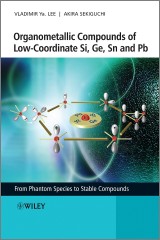Details

Organometallic Compounds of Low-Coordinate Si, Ge, Sn and Pb
From Phantom Species to Stable Compounds2. Aufl.
|
156,99 € |
|
| Verlag: | Wiley |
| Format: | EPUB |
| Veröffentl.: | 22.07.2011 |
| ISBN/EAN: | 9781119956266 |
| Sprache: | englisch |
| Anzahl Seiten: | 448 |
DRM-geschütztes eBook, Sie benötigen z.B. Adobe Digital Editions und eine Adobe ID zum Lesen.
Beschreibungen
Until recently the low-coordinate compounds of the heavier elements of group 14 were known only as transient, unstable species which were difficult to isolate. However recent developments have led to the stabilisation of these compounds and today heavier group 14 element cations, radicals, anions, carbene analogues, alkene and alkyne analogues and aromatics have all been prepared as highly reactive, stable, fully characterizable and readily available organometallic reagents. <p><i>Organometallic Compounds of Low-Coordinate Si, Ge, Sn and Pb</i> describes the chemistry of this exciting new class of organometallics, with an emphasis on their major similarities and differences with the analogous species in organic chemistry. Topics covered include include the synthesis, structure, reactions and synthetic applications of :</p> <ul> <li>Si-, Ge-, Sn and Pb-centered cations, radicals and anions</li> <li>heavy analogues of carbenes: silylenes, germylenes, stannylenes and plumbylenes</li> <li>heavy analogues of alkenes: disilenes, digermenes, distannenes, diplumbenes</li> <li>heavy analogues of alkynes: disilynes, digermynes, distannynes, diplumbynes, and their valence isomers</li> <li>heteronuclear derivatives: silenes, germenes, stannenes, silagermenes, silastannenes, germastannenes</li> <li>heavy analogues of alkenes of the type: >E<sub>14</sub>=E<sub>13</sub>-, >E<sub>14</sub>=E<sub>15</sub>-, >E<sub>14</sub>=E<sub>16</sub> [where E<sub>13</sub>, E<sub>14</sub>, E<sub>15</sub> and E<sub>16</sub> are elements of the groups 13, 14, 15 and 16]</li> <li>cyclic compounds (three-, four-, five-, and six-membered rings)</li> <li>heavy analogues of 1,3-dienes, allenes and other cumulenes</li> <li>heavy analogues of aromatic compounds; including a comparison between organometallic and organic aromaticity</li> </ul> <p><i>Organometallic Compounds of Low-Coordinate Si, Ge, Sn and Pb</i> is an essential guide to this emerging class of organometallic reagents for researchers and students in main group, organometallic, synthetic and silicon chemistry</p>
<b>Preface.</b> <p><b>Abbreviations.</b></p> <p><b>1. Heavy Analogs of Carbenium Ions: Si-, Ge-, Sn- and Pb-Centered Cations.</b></p> <p>1.1 Introduction.</p> <p>1.2 Synthesis of RR'R"E<sup>+</sup>Cations (E = Si-Pb).</p> <p>1.3 Reactions and Synthetic Applications of RRRE<sup>+</sup> Cations<sup>16</sup>.</p> <p>1.4 Theoretical Studies.</p> <p>1.5 Early Studies of RR'R"E<sup>+</sup> Cations: Free or Coordinated?</p> <p>1.6 Stable RR'R"E<sup>+</sup> Cations.</p> <p>1.7 Summary and Outlook.</p> <p>1.8 References.</p> <p><b>2. Heavy Analogs of Organic Free Radicals: Si-, Ge-, Sn- and Pb-Centered Radicals.</b></p> <p>2.1 Introduction.</p> <p>2.2 Early Studies: Transient Species RR'R"E.</p> <p>2.3 Persistent Radicals (Generation and Identification).</p> <p>2.4 Stable Radicals.</p> <p>2.5 Summary and Outlook.</p> <p>2.6 References.</p> <p><b>3. Heavy Analogs of Carbanions: Si-, Ge-, Sn- and Pb-Centered Anions.</b></p> <p>3.1 Introduction.</p> <p>3.2 Synthesis.</p> <p>3.3 Structure.</p> <p>3.4 Reactions and Synthetic Applications.</p> <p>3.5 Recent Developments.</p> <p>3.6 Summary and Outlook.</p> <p>3.7 References.</p> <p><b>4. Heavy Analogs of Carbenes: Silylenes, Germylenes, Stannylenes and Plumbylenes.</b></p> <p>4.1 Introduction.</p> <p>4.2 Generation.</p> <p>4.3 Spectroscopic Identification.</p> <p>4.4 Structure.</p> <p>4.5 Reactions of Transient Species.</p> <p>4.6 Stable/Persistent Silylenes, Germylenes, Stannylenes and Plumbylenes.</p> <p>4.7 Summary and Outlook.</p> <p>4.8 References.</p> <p><b>5. Heavy Analogs of Alkenes, 1,3-Dienes, Allenes and Alkynes: Multiply Bonded Derivatives of Si, Ge, Sn and Pb.</b></p> <p>5.1 Introduction.</p> <p>5.2 Early Studies: Generation and Identification.</p> <p>5.3 Stable Derivatives (Synthesis and Structure).</p> <p>5.4 Summary and Outlook.</p> <p>5.5 References.</p> <p><b>6. Heavy Analogs of Aromatic Compounds.</b></p> <p>6.1 Introduction.</p> <p>6.2 Early Studies.</p> <p>6.3 Stable Compounds (Synthesis and Structure).</p> <p>6.4 Summary and Outlook.</p> <p>6.5 References.</p> <p><b>Index.</b></p>
<p>“In effect, the body of work described constitutes one of the cornerstones of modern main group chemistry and this</p> <p>account provides a highly useful reference source for the specialist as well as a non-intimidating guide for the beginner.” (<i>Applied Organometallic Chemistry</i>, 6 March 2015)</p> <p> </p> <br />
<b>Vladimir Ya. Lee<br /> </b><i>Assistant Professor, Department of Chemistry, Graduate School of Pure and Applied Sciences, University of Tsukuba, Japan<br /> </i>Vladimir Ya. Lee has worked at the Korea Institute of Science and Technology (Korea), at the Université Paul Sabatier (France), and, since 1998, at the University of Tsukuba (Japan). His research interests lie in the field of highly reactive species: carbene analogues, cations, free radicals, anions, multiply bonded compounds and small rings. <p><b>Akira Sekiguchi<br /> </b><i>Professor, Department of Chemistry, Graduate School of Pure and Applied Sciences, University of Tsukuba, Japan<br /> </i>Akira Sekiguchi is Professor of Organic Chemistry at the University of Tsukuba. He received the Japan IBM Science Award in 1996, the Divisional Award of the Chemical Society of Japan (Organic Chemistry) in 1997, and the Alexander von Humboldt Research Award in 2004. His research interests are organosilicon and organolithium chemistry, organogermanium chemistry, and reactive intermediates. In 2006 he received the Kipping Award, the most important prize in the field of silicon chemistry.</p>
Until recently the low-coordinate compounds of the heavy elements of group 14 were known only as transient, unstable species which were difficult to isolate. However recent developments have led to the stabilization of these compounds and today many have been prepared as stable, highly reactive, fully characterizable and readily available organometallic reagents. <p><i>Organometallic Compounds of Low-Coordinate Si, Ge, Sn and Pb</i> describes the synthesis, structure, reactions and synthetic applications of heavy group 14 element cations, radicals, anions, carbene analogues, alkene, diene and alkyne analogues, and aromatics. An emphasis is placed on their major similarities and differences with the analogous species in organic chemistry.</p> <p><i>Organometallic Compounds of Low-Coordinate Si, Ge, Sn and Pb</i> is an essential guide to this emerging class of organometallic reagents for researchers and students in main group, organometallic, synthetic and silicon chemistry.</p>

















